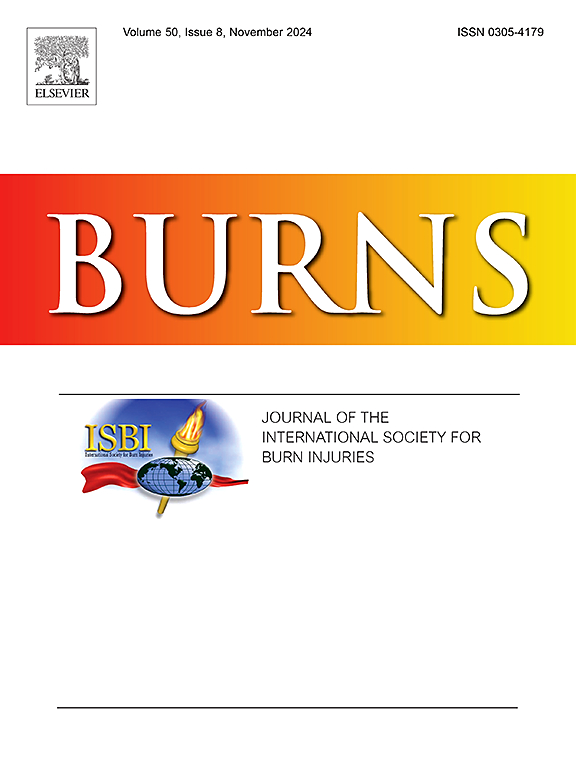CD147抑制通过靶向Smad2信号通路降低TGF-β1诱导的瘢痕疙瘩成纤维细胞中纤维连接蛋白的表达
IF 3.2
3区 医学
Q2 CRITICAL CARE MEDICINE
引用次数: 0
摘要
背景cd147密切参与各种组织的纤维化和肿瘤形成的进展,然而,其在瘢痕疙瘩形成中的作用尚不清楚。在这项研究中,我们研究了CD147在瘢痕疙瘩中的表达并探讨了其功能作用。方法采用免疫组织病理学和western blot方法检测瘢痕疙瘩组织中scd147的表达。培养人瘢痕疙瘩成纤维细胞(KFs), TGF-β1单独或联合CD147抑制剂AC-73处理。Western blot和免疫荧光检测治疗后KFs中CD147和纤维连接蛋白的表达水平。western blot检测CD147抑制剂对TGF-β1诱导的KFs中Smad2磷酸化和纤维连接蛋白水平的影响。最后,建立带瘢痕的裸鼠模型,观察AC-73在体内的治疗作用。结果瘢痕疙瘩组织中scd147的表达明显高于正常皮肤。TGF-β1处理上调培养KFs中CD147和纤维连接蛋白的表达。用AC-73抑制CD147可降低KFs中CD147和纤维连接蛋白的表达水平。此外,AC-73显著减弱TGF-β1诱导的纤维连接蛋白表达,抑制Smad2磷酸化。在裸鼠模型中,AC-73显著降低异种移植瘢痕疙瘩组织的毛重。结论CD147与瘢痕疙瘩的进展密切相关。抑制CD147通过靶向Smad2信号通路下调TGF-β1诱导的KFs中纤维连接蛋白的表达。因此,CD147可能作为瘢痕疙瘩治疗的一个有希望的治疗靶点。本文章由计算机程序翻译,如有差异,请以英文原文为准。
CD147 inhibition reduced fibronectin expression in TGF-β1-induced keloid fibroblasts by targeting Smad2 signaling pathway
Background
CD147 is closely involved in the progression of fibrosis and tumor formation in various tissues, however, its role in keloid formation remains unknown. In this study, we investigate the expression of CD147 in keloids and explore its functional roles.
Methods
CD147 expression in human keloid tissues was assessed using immunohistopathology and western blot analysis. Human keloid fibroblasts (KFs) were cultured and treated with TGF-β1 alone or in combination with the CD147 inhibitor AC-73. Western blot and immunofluorescence were employed to examine CD147 and fibronectin expression levels in KFs post-treatment. Additionally, the effect of CD147 inhibitor on Smad2 phosphorylation and fibronectin protein levels in TGF-β1-induced KFs was evaluated by western blot. Finally, a keloid-bearing nude mouse model was established to investigate the therapeutic effect of AC-73 in vivo.
Results
CD147 expression was significantly higher in keloid tissues compared to normal skin. TGF-β1 treatment upregulated CD147 and fibronectin expressions in cultured KFs. Inhibition of CD147 with AC-73 reduced the expression levels of both CD147 and fibronectin in KFs. Additionally, AC-73 markedly attenuated TGF-β1-induced fibronectin expression and suppressed Smad2 phosphorylation. In the nude mouse model, AC-73 significantly reduced the gross weight of xenotransplanted keloid tissues.
Conclusion
These findings suggest that CD147 is closely involved in keloid progression. Inhibition of CD147 downregulates TGF-β1-induced fibronectin expression in KFs by targeting Smad2 signaling pathway. Thus, CD147 may serve as a promising therapeutic target for keloid treatment.
求助全文
通过发布文献求助,成功后即可免费获取论文全文。
去求助
来源期刊

Burns
医学-皮肤病学
CiteScore
4.50
自引率
18.50%
发文量
304
审稿时长
72 days
期刊介绍:
Burns aims to foster the exchange of information among all engaged in preventing and treating the effects of burns. The journal focuses on clinical, scientific and social aspects of these injuries and covers the prevention of the injury, the epidemiology of such injuries and all aspects of treatment including development of new techniques and technologies and verification of existing ones. Regular features include clinical and scientific papers, state of the art reviews and descriptions of burn-care in practice.
Topics covered by Burns include: the effects of smoke on man and animals, their tissues and cells; the responses to and treatment of patients and animals with chemical injuries to the skin; the biological and clinical effects of cold injuries; surgical techniques which are, or may be relevant to the treatment of burned patients during the acute or reconstructive phase following injury; well controlled laboratory studies of the effectiveness of anti-microbial agents on infection and new materials on scarring and healing; inflammatory responses to injury, effectiveness of related agents and other compounds used to modify the physiological and cellular responses to the injury; experimental studies of burns and the outcome of burn wound healing; regenerative medicine concerning the skin.
 求助内容:
求助内容: 应助结果提醒方式:
应助结果提醒方式:


